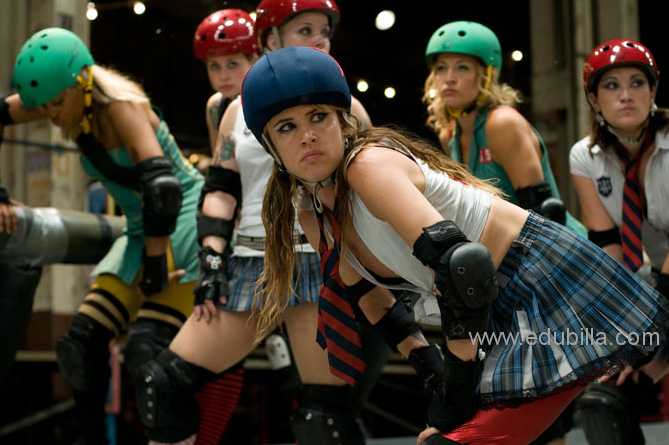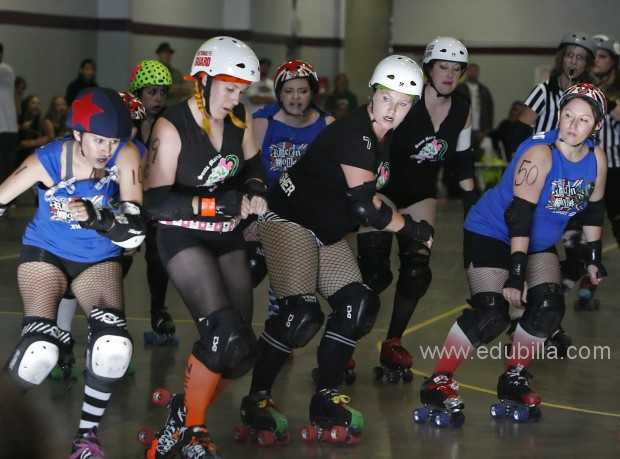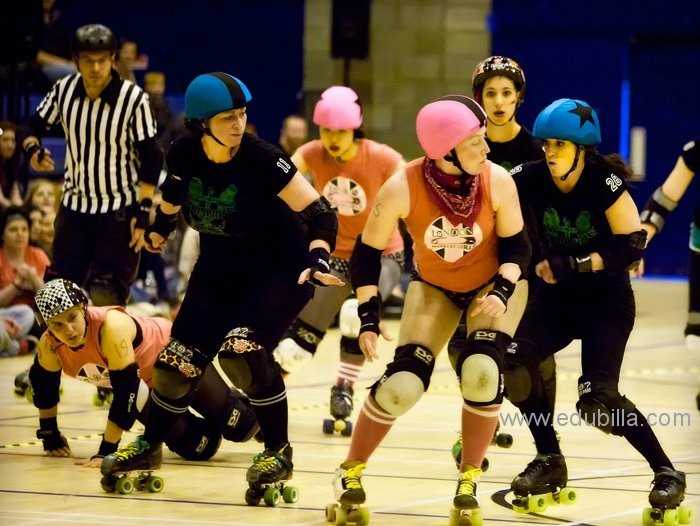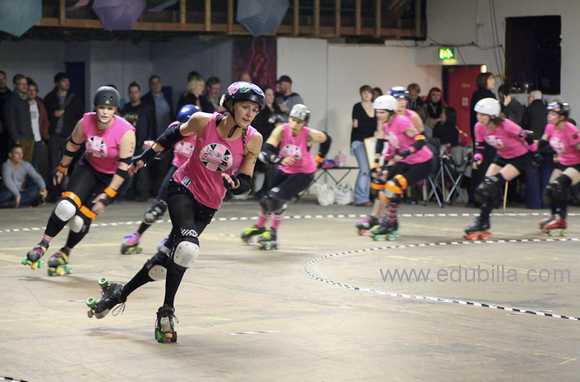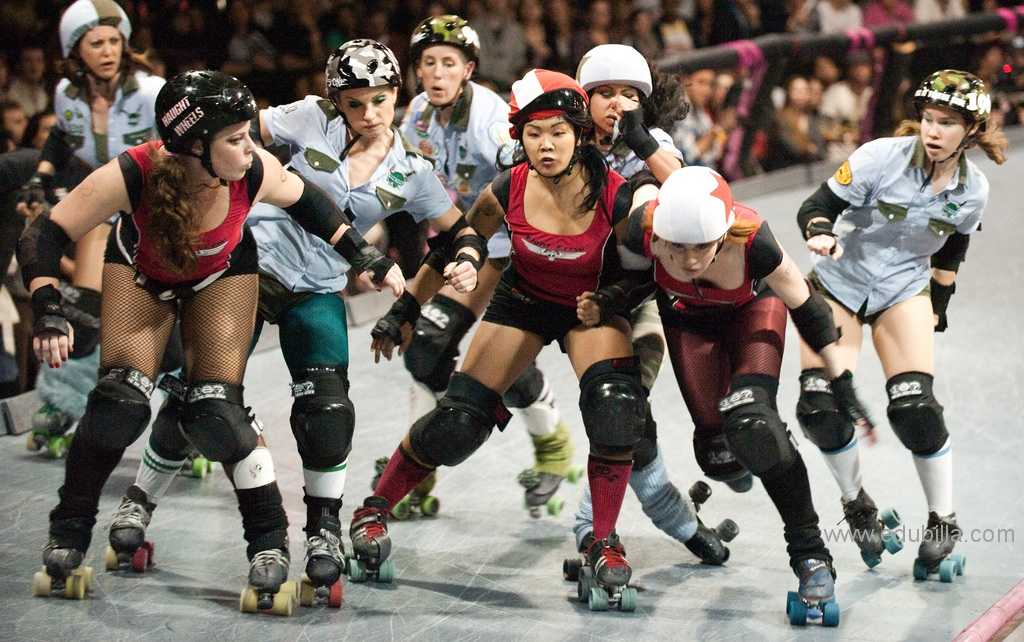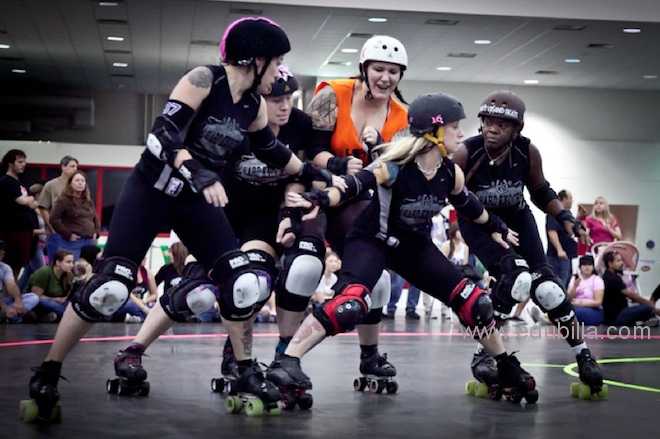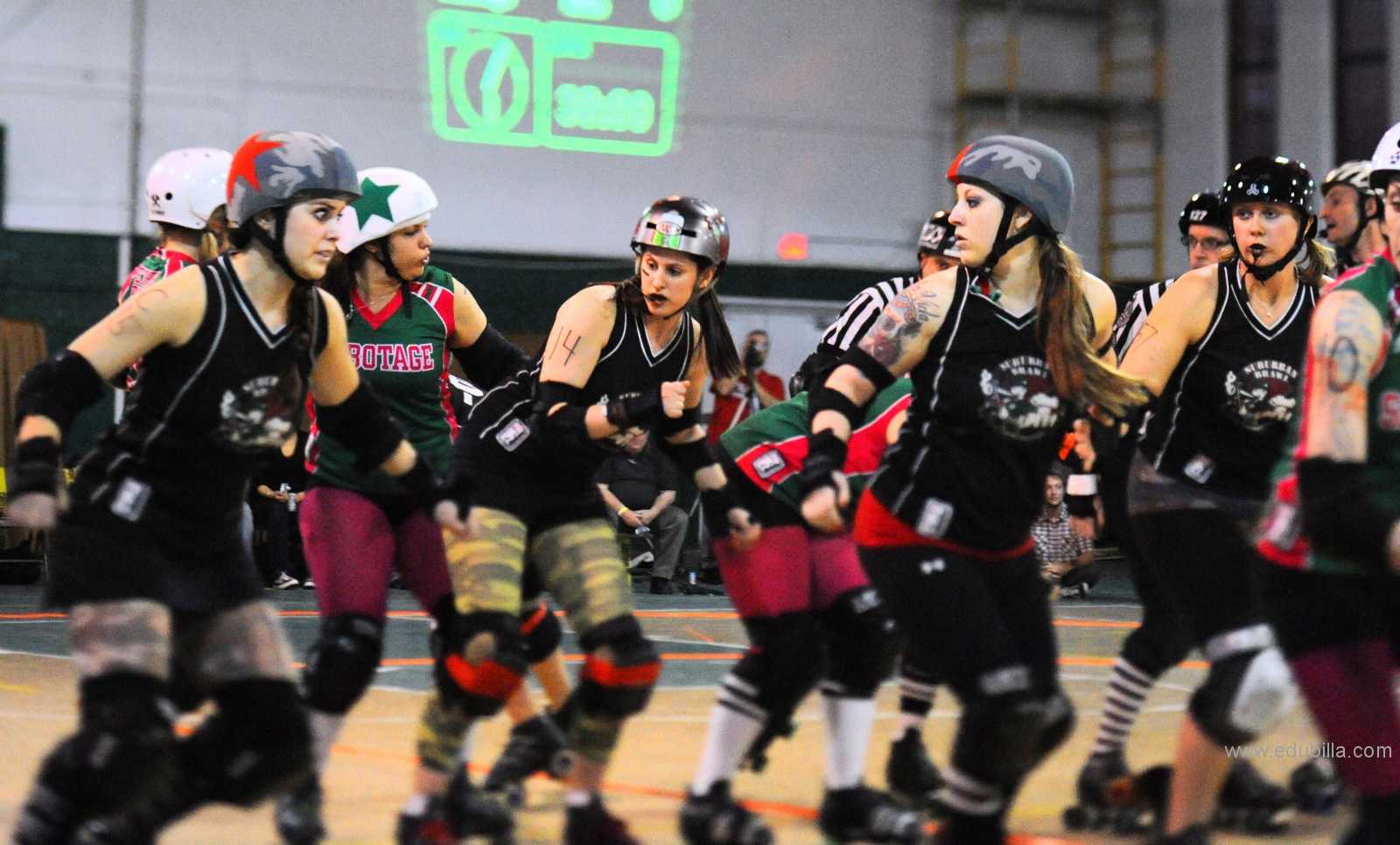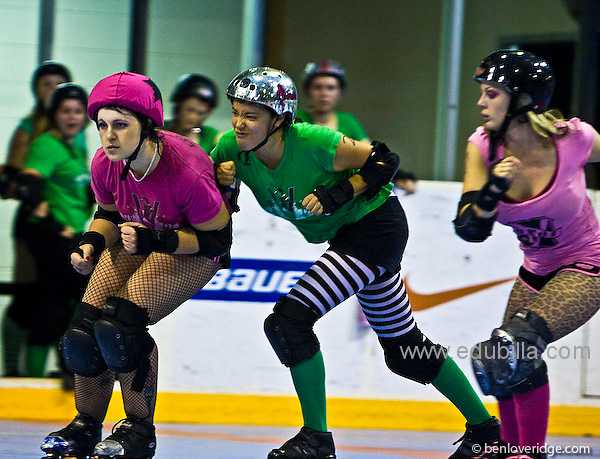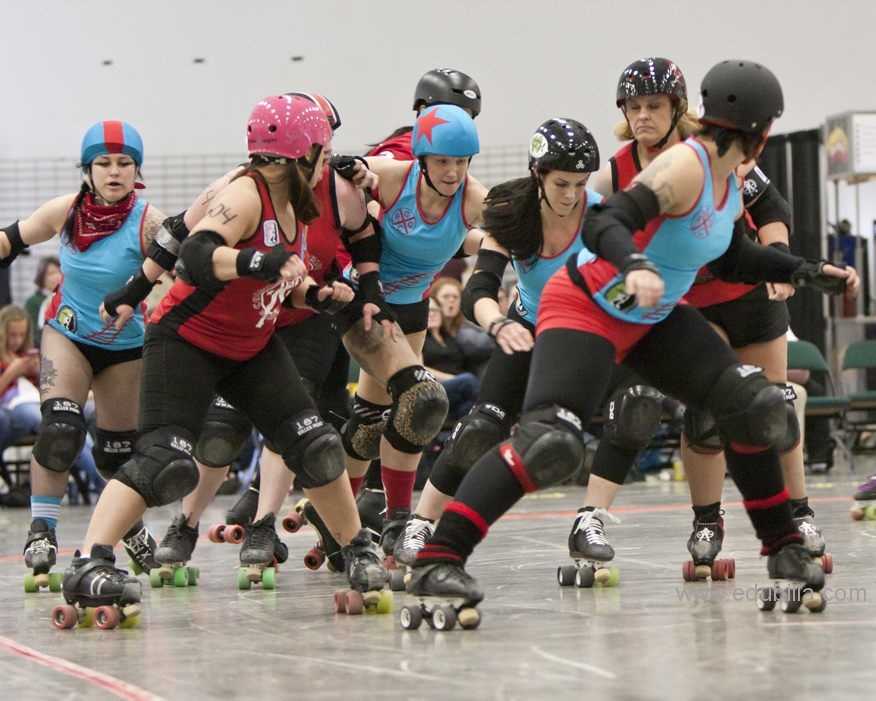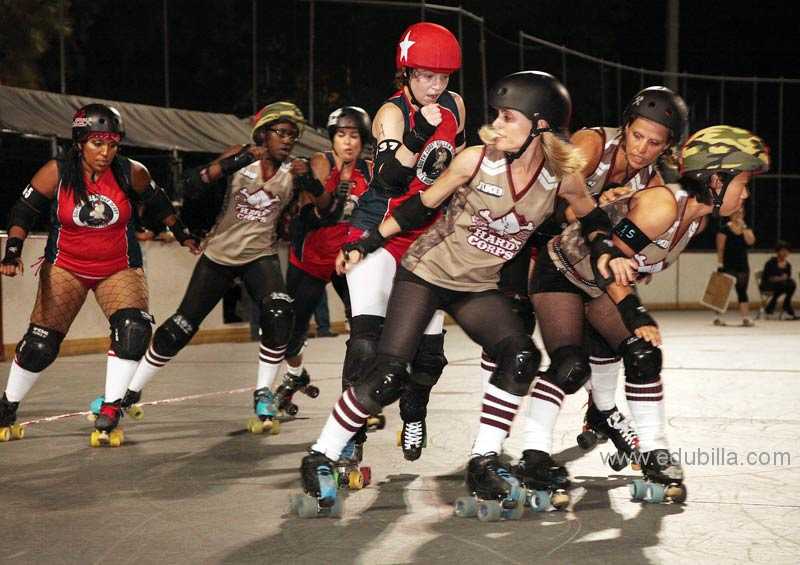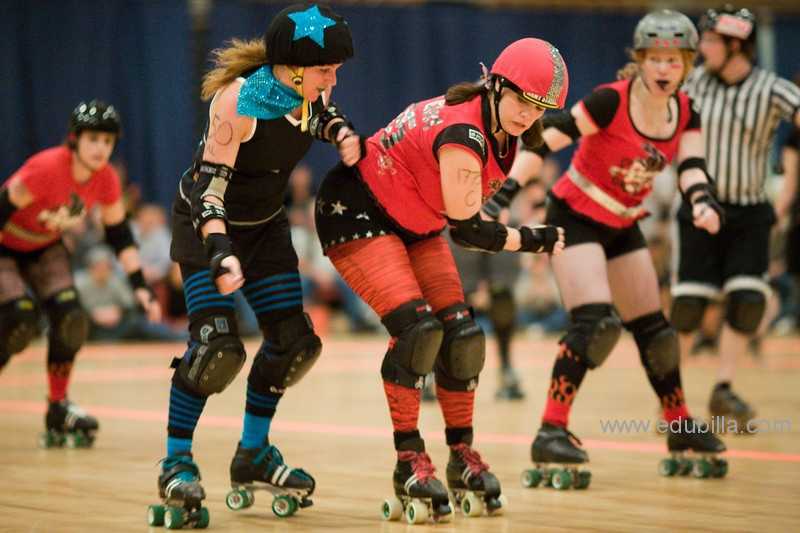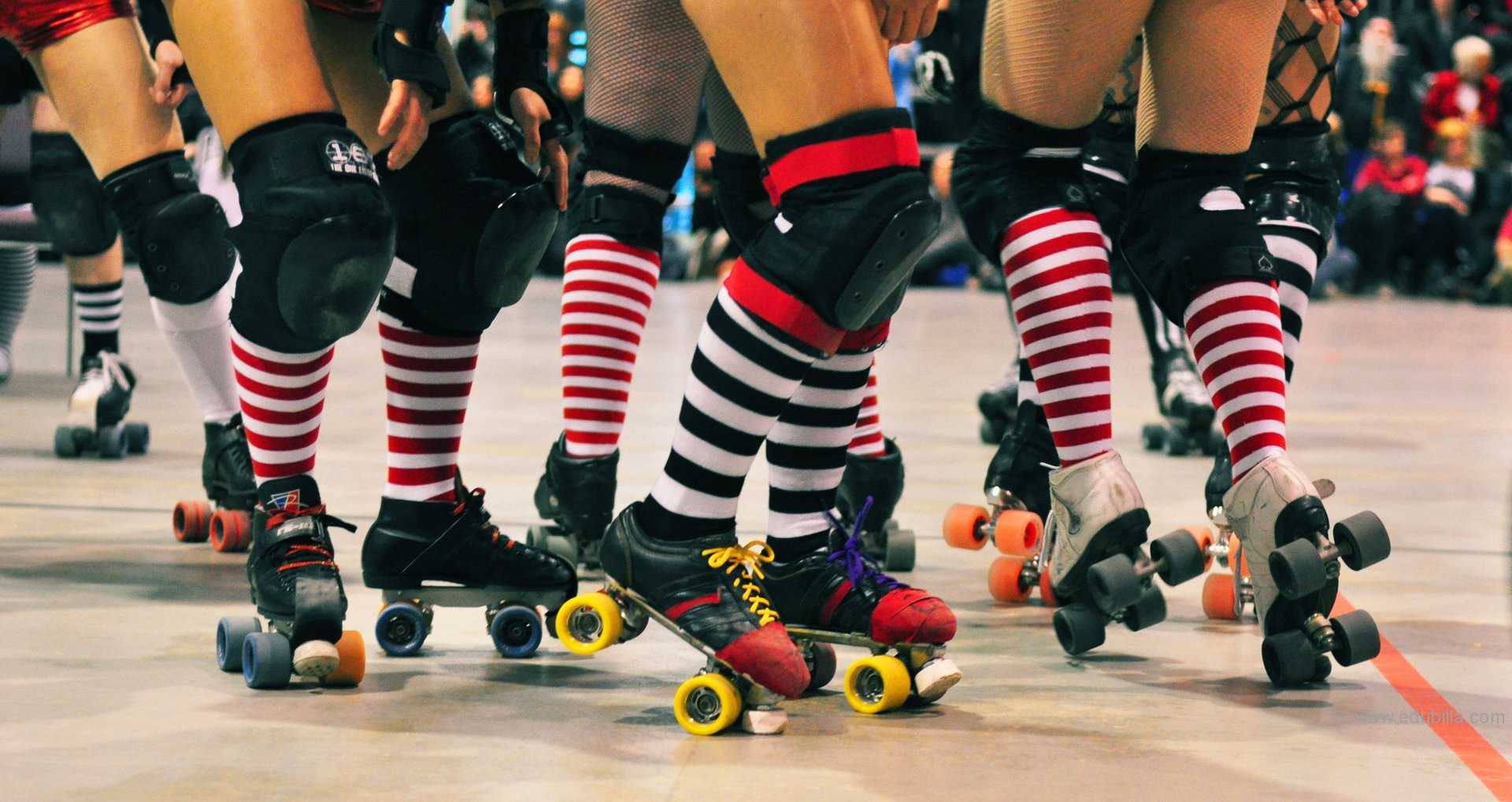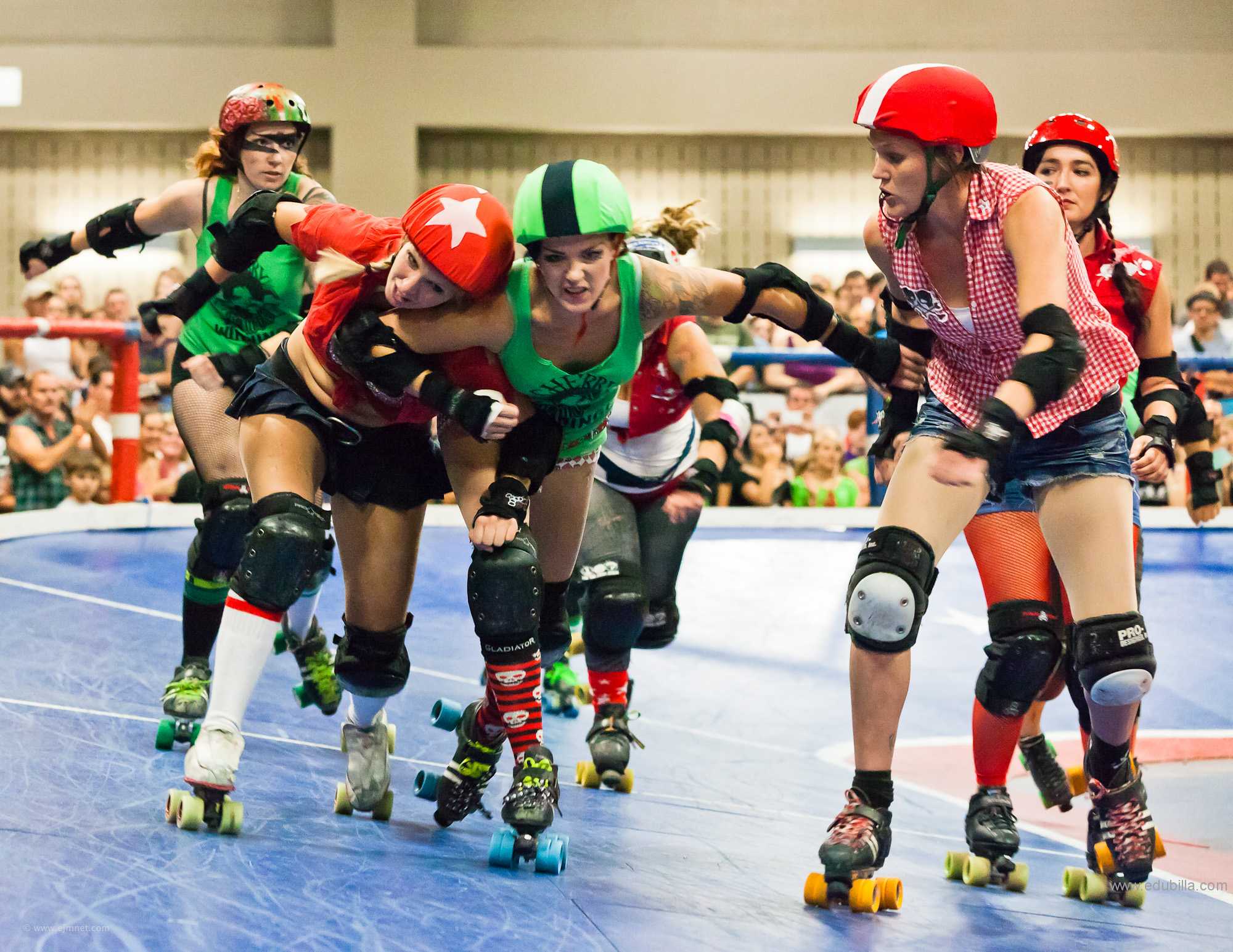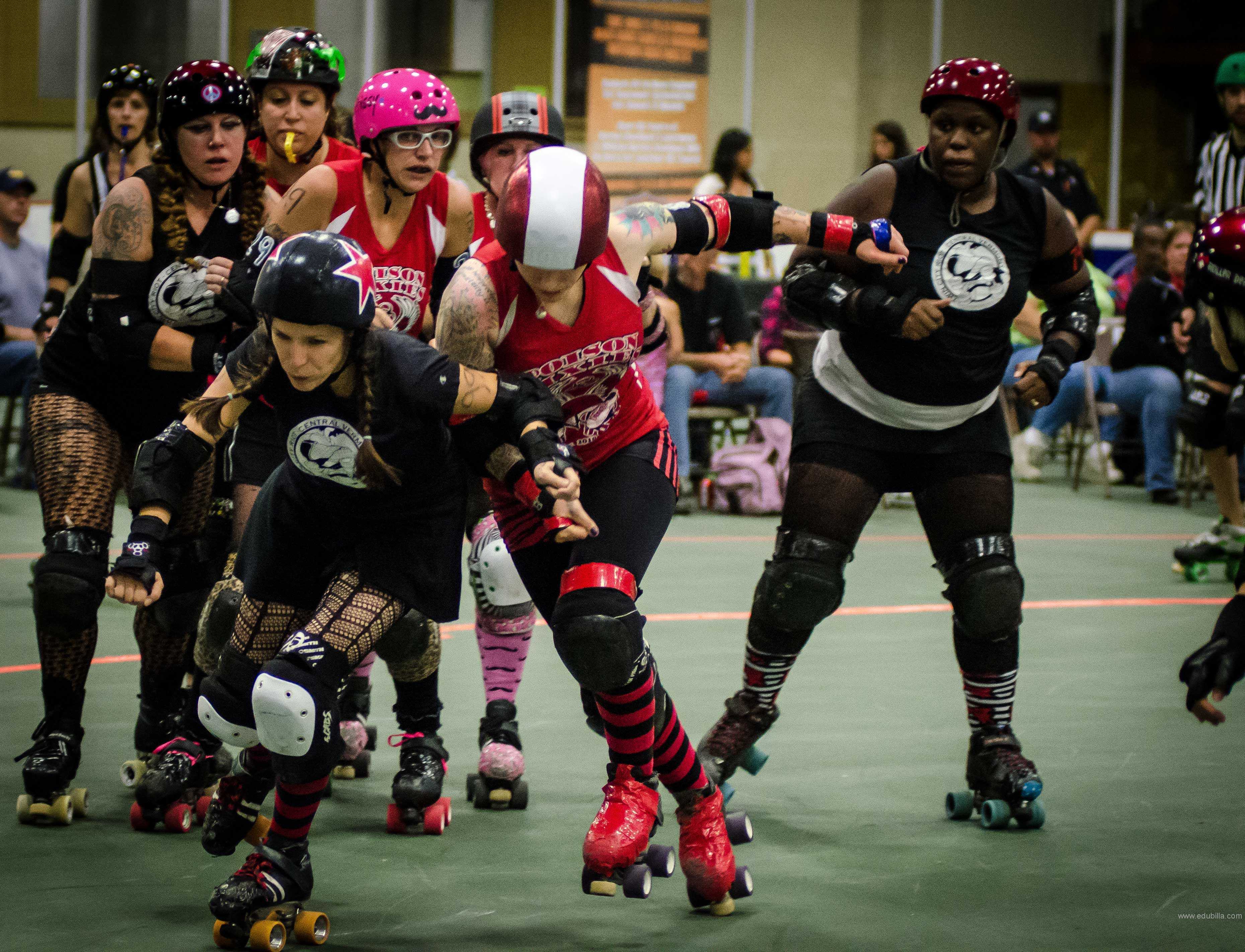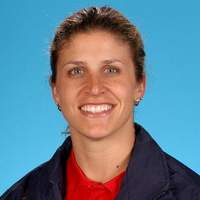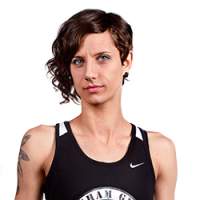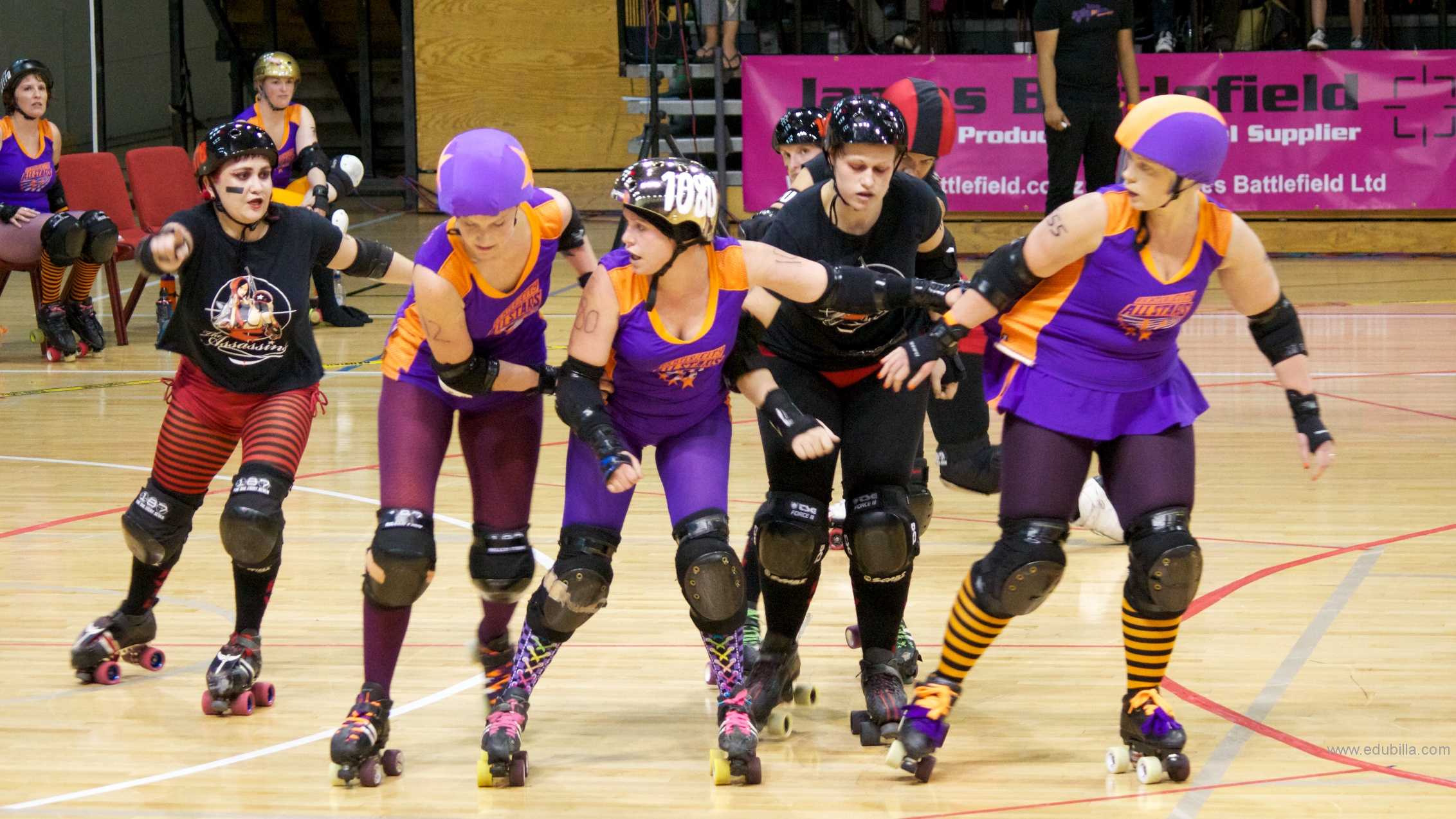
Overview Of Roller derby
Roller derby is a contact sport played by two teams of five members roller skating in the same direction around a track. Game play consists of a series of short matchups ("jams") in which both teams designate a scoring player (the "jammer") who scores points by lapping members of the opposing team. The teams attempt to hinder the opposing jammer while assisting their own jammer—in effect, playing both offense and defense simultaneously. Roller derby is played by approximately 1,250 amateur leagues worldwide, nearly half of them outside the U.S.
While the sport has its origins in the banked-track roller skating marathons of the 1930s, Leo Seltzer and Damon Runyon are credited with the basic evolution of the sport to its initial competitive form. Professional roller derby quickly became popular; in 1940 more than 5 million spectators watched in about 50 US cities. In the ensuing decades, however, it predominantly became a form of sports entertainment where the theatrical elements overshadowed the athleticism. This gratuitous showmanship largely ended with the sport's contemporary grassroots revival in the first decade of the 21st century. Although some sports entertainment qualities such as player pseudonyms and colorful uniforms were retained, scripted bouts with predetermined winners were abandoned.
Modern roller derby is an international sport dominated by all-female amateur teams, in addition to a growing number of male, co-ed, and junior roller derby teams, and was (as a roller sport) under consideration for the 2020 Olympics. Most modern leagues (their back-office volunteers included) share a strong "do it yourself" ethic which combines athleticism and elements from camp. As of 2014 the Women's Flat Track Derby Association, or WFTDA, had 243 full member leagues and 114 Apprentice Leagues.
Game Rules
SETUP & SCORING
Each team fields five players at a time.
Out of those five players, four are BLOCKERS and one is the JAMMER (point scorer).
The four blockers from each team line up together between a designated "Pivot Line" and "Jammer Line" marked on the track, to form a PACK, while the two jammers line up behind the Jammer Line.
The skater wearing the star on her helmet is the jammer. The skater wearing the stripe on her helmet is called the PIVOT. The pivot is commonly the pack leader and defensive play caller, similar to football's middle linebacker position.
On the whistle the pack and jammers may begin to engage each other.
On the first lap, the jammers earn no points, but the first jammer to legally pass each blocker on the opposing team and clear the pack is called LEAD JAMMER. You can tell if a skater is the Lead Jammer by looking at her designated jammer ref. The jammer ref will point to the jammer and hold his/her hand up in an “L” shape. The Lead Jammer reserves the right to strategically end the jam before the two minutes are completed by repeatedly gesturing with her hands on her hips. If both jammers commit fouls on their first lap, there is no Lead Jammer in that jam and it will run for the full 2 minutes.
Jammers lose Lead Jammer status if they are sent to the penalty box during the jam.
After a jammer completes her initial lap, she scores 1 point for each opposing skater she passes.
Jammers automatically score points against opposing skaters serving in the penalty box.
Jammer referees hold up fingers at the conclusion of each lap for points just earned.
TIMING
Each two minute play is called a JAM.
Between each jam, there are 30 seconds for teams to line up for the next jam.
There are two halves in a BOUT. Each half is 30 minutes long and has an unlimited number of jams.
Teams may freely substitute players between jams, except for players stuck in the penalty box.
PENALTIES
Blocking with forearms, hands, elbows, or a helmet
Tripping, kicking, or blocking with feet or legs
Blocking while 20 feet ahead of or behind the pack (”out of play”)
Intentionally destroying the pack, such as by taking a knee or leaving the track in a way which rendering the remaining players ineligible to block
Blocking a skater in her back or head
Blocking while out of bounds, or blocking a skater who is out of bounds
Skating out of bounds to get around other skaters (”cutting the track”)
Illegal procedures: false starts, too many skaters on the track
THE PENALTY BOX
A penalty costs 30 seconds of jam time in the box, served immediately so long as a seat is available in the box.
Refs gesture skaters to the box with a swooping motion of one finger to direct the skater off the track.
A jammer in the box is released immediately if the other jammer also lands in the box.
Detailed Roller derby Rules Can Be Downloaded From Documents
Equipments Need For Roller derby
Quad Skates:
Riedell makes several levels of a boots that accommodate many skill levels. If you are new to the sport you may want to start out with the She Devil an entry level inexpensive boot, prices range from $100 and up. Once a boot has been chosen you will need to decide on a plate, SureGrip makes a good solid plate. Wheels and bearings are a personal preference, there are may manufacturers to choose from, most skate shop and online vendors offer packages which include the boot plate, wheels and bearings.
Helmet:
A proper fitting helmet is arguably the most important piece of safety gear you will invest in. There are two kinds of helmets to choose from; a hard foam lined single impact PSC rated up to 30mph helmet that should be replaced after one hard impact, bicyclists typically wear this type of helmet. The second choice is a multi impact, or skateboard helmet which is lined with a softer foam and is not rated or certified, this type of helmet would not need to be replaced as often however the foam liner breaks down over time and will need to be replaced periodically. Your helmet should fit snug, almost to the point of discomfort. There are many brands to choose from consult your league experts or local skate shop.
Mouth Guards:
Mouth guards protect against concussions, the inside of your mouth, and teeth. They are a very important part of the derby skater’s equipment. Our friends over at Impact Mouthguards have a custom mold model that many of our skaters and trainers use and really like. Once you become a member of our brats family, we’ll send you a code you can use for an online discount on these amazing mouthguards.
Knee Pads:
Your knees are important, young girls bodies are still growing and their knee’s need attention. Make sure that the knee pad fits tight enough so that it will not slide off. Knee pads will compress over time and wear out, you should inspect them regularly for cracks, rips, and exposed rivets. Some good name brands are Pro-Tec, Rector, 187, TSG, and Triple Eight. You can plan on spending $35 to $85 on knee pads.
Wrist Guards:
Wrist guards are designed to protect your hands and wrist, they absorb impacts to the hand and give support to your wrists. Some guards have splints on the top or bottom and some have splints on both sides. Like all protective gear your wrist guards need to be sized correctly for optimum support, keep in mind that you will replacing the wrist guards often so inspect frequently.
Elbow Pads:
Elbow pads should fit snuggly just like knee pads. You should treat your elbow pads just as you would knee pads, inspection, care and maintenance are essential for long lasting protection.
Hip Pads:
Hip pads protect your hip bones, tailbone, and help to prevent large hematomas. McDavid makes a custom pad that is longer, has a thicker tailbone lining, and wraps around to protect the hip bones better. This style was designed for the roller girl at the request of FastGirl Skates in Seattle, www.fastgirlskates.com. Hip pads that have a hard shell are not recommended because they can hurt an opposing skater.
Gladiators:
Gladiators are extra padding under the knee pad that are designed to support ligaments, cartilage, and the patella. Additionally they help keep the knee pad from slipping. The Gladiator is optional and not a required piece of gear.
History Of Roller derby
The history of roller derby traces the evolution of roller skating races into a unique sport which has undergone several boom-and-bust cycles throughout most of the 20th century. Although it was a form of sports entertainment for much of its existence, a grassroots, early 21st century revival spearheaded by women has restored an emphasis on athleticism.
Professional endurance races:
The growing popularity of roller skating in the United States led to the formation of organized multi-day endurance races for cash prizes, as early as the mid-1880s.Speed and endurance races continued to be held on both flat and banked tracks in the century's first three decades and spectators enjoyed the spills and falls of the skaters.The term derby was used to refer to such races by 1922.
Evolution to contact sport:
The endurance races began to transform into the contemporary form of the sport in the mid-1930s, when promoter Leo Seltzer created the Transcontinental Roller Derby, a month-long simulation of a road race between two-person teams of professional skaters. The spectacle became a popular touring exhibition. In the late 1930s, sportswriter Damon Runyon persuaded Seltzer to change the Roller Derby rules to increase skater contact. By 1939, after experimenting with different team and scoring arrangements, Seltzer's created a touring company of four pairs of teams (always billed as the local "home" team versus either New York or Chicago), with two five-person teams on the track at once, scoring points when its members lapped opponents.
Television:
In 1948, Roller Derby debuted on New York television—broadcasting well before television viewership was widespread. The broadcasts increased spectator turnout for live matches. For the 1949–1950 season, Seltzer formed the National Roller Derby League (NRDL).The NRDL consisted of six teams. NRDL season playoffs sold out Madison Square Garden for a week. During the late 1950s and 1960s, the sport was broadcast on several networks, but attendance declined. Jerry Seltzer (Leo's son), the RollerJam "commissioner", hoped to use television to expand the live spectator base. He adapted the sport for television by developing scripted story lines, and rules designed to improve television appeal; derby's popularity declined in spite of this.
1989 saw the debut of RollerGames, a show which presented an even more theatrical variant of roller derby for national audiences, which ran one season for some of its distributors for syndication went bankrupt. It used a figure-8 track and different rules adapted for this track. Bill Griffiths, Sr. served as commissioner while his son, Bill Griffiths, Jr. served as manager for the L.A. T-Birds, who (according to the storylines) were seeking revenge on the Violators (led by Skull) for cheating in the Commissioner's Cup and stealing it from them when the Skull interfered with gameplay. The other teams included the Maniancs (led by Guru Drew), Bad Attitude (led by Ms. Georgia Hase), the Rockers (led by DJ Terringo and consisting of skaters that were also professional rock and roll musicians), and Hot Flash (led by Juan Valdez Lopez).
In 1999, Spike TV (TNN at the time) debuted RollerJam, which used exactly the same rules on just a banked oval track as classic roller derby, but allowed for inline skates to be used (although some skaters went with traditional quad skates). Jerry Seltzer was commissioner for this version.
Jam On, Jam Off:
After terminating the contract with ABC in 1951, Seltzer negotiated a deal with General Motors to sponsor the broadcast of games on NBC. The deal fell through when, according to Seltzer, General Motors, fuming over an NCAA decision preventing them from sponsoring the broadcast of University of Notre Dame football games, lost interest in televising any sports at all. A handful of independent TV stations continued to broadcast games, but the loss of network broadcasting caused fan interest to plummet. Madison Square Garden no longer wanted to host matches, fan clubs disbanded, and Seltzer returned to pursuing real estate interests. At some point, Seltzer changed his residence to Encino (Los Angeles) a westward move that foreshadowed changes to come.
In July 1953, citing the effects of the Korean War and a dearth of venues, Leo Seltzer moved the Derby from New York to Los Angeles and created the L.A. Braves for their debut at the Rose Bowl. The Braves became the first international team when a tour of Europe was launched in 1953.
However, this was not the first time audiences outside the U.S. had seen the game played live. A separate organization, International Roller Speedway, known in some countries as Roller-Catch, formed in 1937 and toured Europe, where they played at the Harringay Arena in London, and the Philippines. Roller Speedway was a modified version of the sport and normally featured two teams, representing Europe (the "home" team) and USA. The 1950 film The Fireball, starring Mickey Rooney, was based on the life of one of the league's stars, Eddie Poore, who skated under the name Eddie Cazar. Roller Speedway ceased operations in 1952.
In 1954, the Derby established the most fabled team in the history of the sport, the longtime champion San Francisco Bay Bombers. Stars on this team eventually included Charlie O'Connell, Joanie Weston, and Ann Calvello.
In his keynote address at the 2007 roller derby convention RollerCon, Leo's son Jerry Seltzer revealed that at its peak in the 1950s, the National Roller Derby League had just 83 skaters spread among its six teams.
Origin Of Roller derby
Endurance races:
The growing popularity of roller skating in the United States led to the formation of organized endurance races as early as 1884, when skater Victor W. Clough skated 100 miles over the course of nearly ten hours in Geneseo, Illinois. In 1885, a six-day "go-as-you-please" competition was staged at Madison Square Garden in New York City, with 36 skaters competing for $500 in prize money. Two deaths resulted from the six-day race: both the winner, William Donovan, and skater Joseph Cohen died shortly after the race was completed. Though the inquest that resulted from Cohen's death led to a recommendation for a law prohibiting roller skating activities exceeding four hours in length, a second six-day race was announced in May 1885.
popularity:
The popularity of roller skate racing, including endurance events, continued in the early 20th century. Races routinely featured amateur skaters as well as professionals, some of whom toured as troupes. Due to rowdiness at some events, including tripping and pushing, speed roller skating acquired a reputation for being something less than a legitimate sport. The International Skating Union of America, a competitor of the International Skating Union, formed in 1907 partly in response. This network of regional associations lasted 20 years, organized championship races, and established rules that prohibited rough play.
Seltzer's walkathons:
In 1929, as the Great Depression began, struggling film publicist Leo Seltzer (1903–1978) observed that cash prize-awarding dance marathons among out-of-work contestants and spectators were undermining attendance at his Oregon cinema chain, so he sought ways to capitalize on the trend.Seltzer began holding his own dance marathons, dubbed "walkathons" since contestants usually ended up just shuffling around for the duration of the contests, which could run as long as 40 days. Hundreds of unemployed people participated, hoping to win cash prizes. The contests were emceed by celebrities like Frankie Laine and Red Skelton, and grossed $6 million in three years. Seltzer held his first commercial walkathon in 1931 in Denver, Colorado, then held 22 more, grossing $2 million before retiring, citing that the events had become "vulgar."
In 1933, Seltzer moved his family to Chicago, Illinois and began booking events at the Chicago Coliseum.
Transcontinental Roller Derby:
In 1935, the novelty of walkathons had worn off, but a roller skating fad arose again. According to folklore, Seltzer read an article in Literary Digest magazine that said ninety-three percent of Americans roller skated at least once in their lives. While discussing the article with regular patrons at Ricketts, a restaurant in Chicago's Near North Side, Seltzer was challenged to invent a sport incorporating roller skating. Jotting his ideas onto a tablecloth, he decided to combine then-popular six-day bicycle races and roller skating. Some sources give co-credit for the idea to Leo's brother Oscar.
In August of that year, Seltzer organized his own Transcontinental Roller Derby, an event more than a month long. Staged at the Chicago Coliseum, it was a simulation of a cross-country roller skating race in which 25 two-person (male-female) teams circled a wooden, oval, banked track thousands of times, skating 11½ hours a day, to cover 3,000 miles, the distance between Los Angeles and New York City. Team standings were indicated by multicolored lights tracking their imaginary progress on a large map of the United States. Teams were disqualified if both members were off the track during skating times. Sixteen teams dropped out due to injuries or exhaustion, but nine teams finished, and the winning team, Clarice Martin and Bernie McKay, held the lead for the last 11 days of the event.Although Seltzer's spectacle had elements of originality, a U.S. District Court, ruling against Seltzer when he sued a competitor in 1938, found that the marathon roller race concept had long been in the public domain, so Seltzer couldn't claim copyright violation.
Disaster:
On March 24, 1937, 21 members of a touring group of Roller Derby skaters and support personnel were killed when their chartered bus blew a tire while going 40 mph down a hill on U.S. Route 50, collided with a bridge abutment, rolled onto its side and burst into flames, trapping passengers inside. The accident occurred near Salem, Illinois, as the bus was en route from St. Louis, Missouri to Cincinnati, Ohio for another performance. Only a few of the 23 passengers escaped the burning wreckage, and two of them died later from their injuries, bringing the total fatalities to 19 or 20 (sources vary).The ghastly tragedy nearly put Seltzer out of business, but replacement skaters were signed and Roller Derby survived. As a tribute to those killed in the tragedy, the number "1" was permanently retired for all Roller Derby teams.
Governing Bodies
Women's Flat Track Derby Association:
The Women's Flat Track Derby Association (WFTDA) is an association of women's flat track roller derby leagues around the world. The organization was founded in April 2004 as the United Leagues Coalition (ULC) but was renamed in November 2005. It is registered in Raleigh, North Carolina as a 501(c)(6) business league organization, which is a type of non-profit organization. According to its mission statement, the organization "promotes and fosters the sport of women's flat track roller derby by facilitating the development of athletic ability, sportsmanship, and goodwill among member leagues" and its governing philosophy is "by the skaters, for the skaters" — the primary owners, managers, and operators of each member league and of the association are women skaters, although this does not preclude any particular business structure (leagues don't have to be legally incorporated or internally egalitarian). The mission statement also says WFTDA sets "standards for rules, seasons, and safety, and determining guidelines for the national and international athletic competitions of member leagues" and says "all member leagues have a voice in the decision-making process, and agree to comply with WFTDA policies.
History:
In 2004, the ULC was an informal electronic message board through which established leagues compared notes in order to prepare for interleague play, and it was also used to exchange information to help new leagues that were just getting started.
The ULC evolved into a more formal organization in July 2005, when representatives of 20 leagues met in Chicago to discuss establishing a governing body for women's flat-track roller derby. At the meeting, a voting system was established, as was a set of goals and a timeline was established for facilitating interleague play. Among these goals was the production of a standard track design and standard game rules. The design and rules which were settled upon and distributed later that year. In November 2005, the ULC voted to change its name to the Women's Flat Track Derby Association.
In early 2006, a track design and rules were published on the organization's fledgling web site. By that time, the organization had grown to 30 leagues, a cap decided upon at the July 2005 meeting.
Induction of new member leagues was postponed until revised membership requirements could be discussed at the next face-to-face meeting, scheduled for the end of May. However, in February 2006, soon after the initial requirements were published and following the fragmentation of several leagues, a "multi-league per city" clause was added to the membership requirements. Although throughout early and mid-2006 the clause was listed as a requirement for membership, WFTDA's web site was later updated to state that the policy is "unofficial". WFTDA also claims the policy is intended to uphold goodwill between members — by excluding leagues not likely to find favor with established members — as well as to prevent rival leagues in the same city from being privy to each other's "proprietary information."
Following the May 2006 meeting, a press release was issued to promote the organization and publicize the meeting. The June statement covered the following points:
-Representatives of the "30 founding leagues" met to discuss rules, business structure, skill standards, rankings and future tournaments.
--30 more leagues were slated to be inducted in mid-2006, bringing the total membership to 60.
Version Two of the WFTDA Flat Track Derby Standardized Rules for Interleague Play was announced as forthcoming in mid-2006.
--Changes to the member league divisions were announced (see table below).
A 2007 tournament schedule was announced.
The History of WFTDA at a Glance:
In mid-2007, WFTDA's Web site was updated to reflect changes in the requirements for placement in the three divisions: it is now based on seniority, as measured by readiness for inter-league play and the number of seasons completed while a WFTDA member (see table below).
In September 2007, WFTDA was admitted to USA Roller Sports (USARS) as a Class V member — a national amateur roller skating organization — and a WFTDA delegate joined the USARS Board of Directors.
In February 2008, WFTDA announced that leagues from Canada would be eligible for membership.
In June 2008, the WFTDA Rules Committee created a Question and Answer forum to "provide definitive and final answers about the Women’s Flat Track Derby Association Standard Rules.
In July 2008, WFTDA began a referee certification program.
In September 2008, WFTDA had grown to 60 leagues, and the official WFTDA magazine fiveonfive began publication.
In November 2008, a flyer was published announcing that for 2009, WFTDA member leagues would be divided into four regions, rather than two: West, South Central, North Central, and East. Each region has a tournament scheduled, followed by a national championship.
In January 2009, Montreal Roller Derby became the first Canadian league admitted as a member. The league was WFTDA's 66th member, and was placed in the East region.
Also in January 2009, the WFTDA announced it would stop accepting applications for new membership from February until July, so that it could concentrate on internal restructuring in order to, among other things, "grow the scope" of the organization.
In April 2009 the WFTDA published revised rules, WFTDA Rules 4.0. The revised rule-set became effective for all WFTDA sanctioned bouts on June 1, 2009.
In May 2009, the first officially sanctioned international WFTDA bout was played between Montreal Roller Derby and Harrisburg Area Roller Derby at the Olympic Skating Center in Enola, PA.
In July 2009, the WFTDA announced its new apprentice program for aspiring member leagues that replaced its traditional membership application process. The program is designed to act as a "WFTDA 101" tutorial, and will match new leagues with an established WFTDA mentor, who will guide the apprentice through the processes and requirements necessary to becoming a full member. Upon completion of the program, apprentice leagues will have the knowledge (and the recommendations) needed to apply for full WFTDA membership.
In November 2009 the WFTDA opened for worldwide membership and the London Rollergirls became the first league outside North America to join as apprentice members.
In June 2010, the WFTDA announced the first round of Apprentice league graduates, and formed two new regions outside of the United States. (Leagues in those regions will compete in the closest US region until they develop more fully.)
In March 2012, Bear City Roller Derby from Berlin, Germany became the WFTDA's first full member league in continental Europe.
In June 2013 the Rock n Roller Queens of Bogota, Colombia become the first full member South American league. The Tokyo Roller Girls and Kokeshi Roller Dolls become the first full member leagues in Asia.
To Visit WFTDA Click Here.
Awards Related To Roller derby
Whammy Awards:
The Whammy Awards is our year-end event where we celebrate our successes on and off the track. Where we honor our skaters, our officials, and our non-skating volunteers. It takes an army of dedicated and passionate folks to run our league, our non-profit business, our rec and junior programs, and to put on our bouts. In a night of costumes and speeches, food and drink and dancing we let loose and celebrate this incredible organization and the people who make it all happen.
Awards:
-League Awards
-Texas Rollergirls Awards
-Fan Favorite Awards
-Hell Marys
-Honky Tonk Heartbreakers
-Hotrod Honeys
-Hustlers
-Firing Squad
-Texecutioners
-DerbyLove Awards
Derbytaunt Awards:
Each year we hold an annual party known as Derbytaunt, it’s our chance to get all dressed up and celebrate the previous season. This year we also gave out awards that were voted on by league members – with the exception of the Fan Favorites who were chosen by the fans.
-New Jax City Rollers
-Fan Favorites
-NSO/Ref Awards
Sample Documents Of Roller derby
-Sachin Tendulkar

